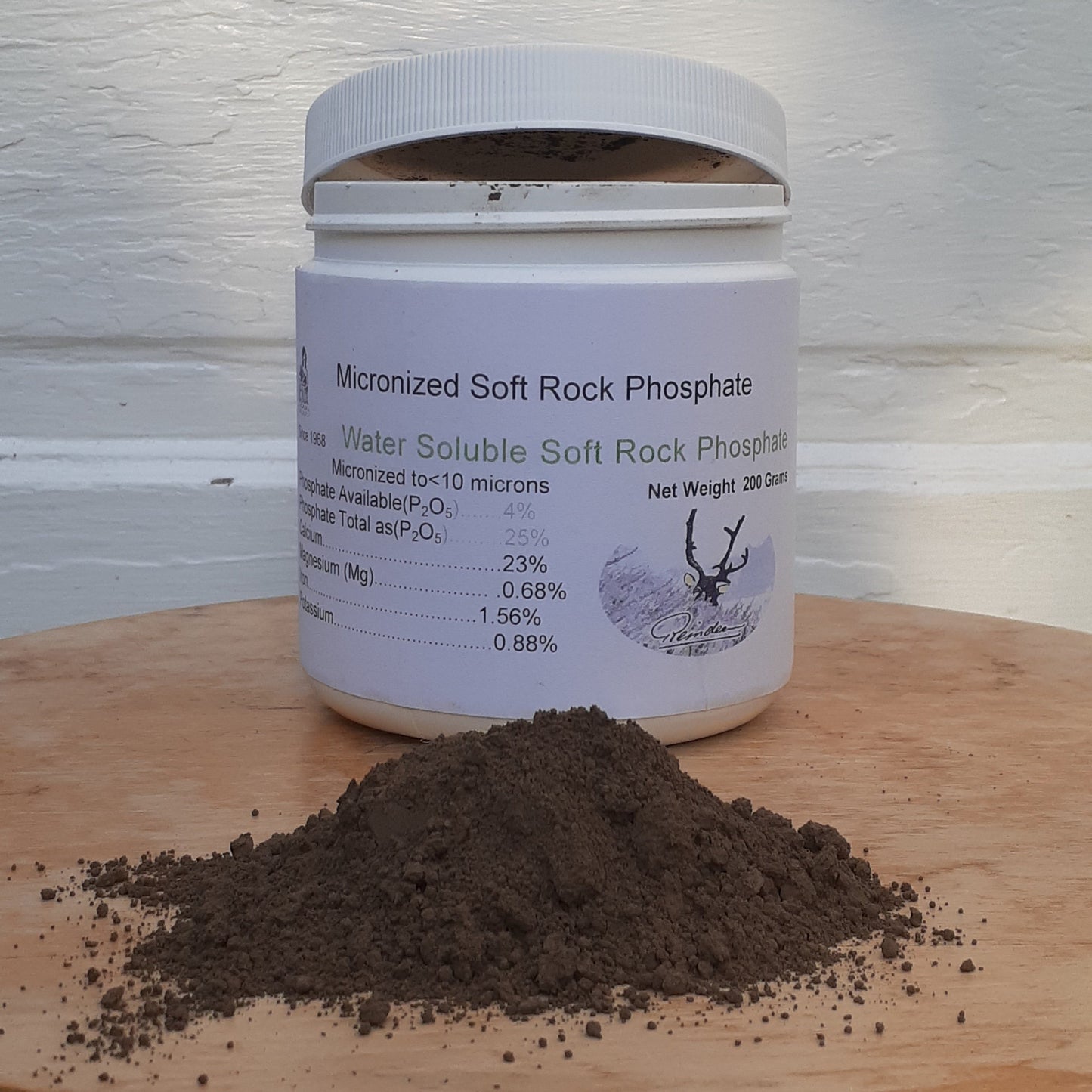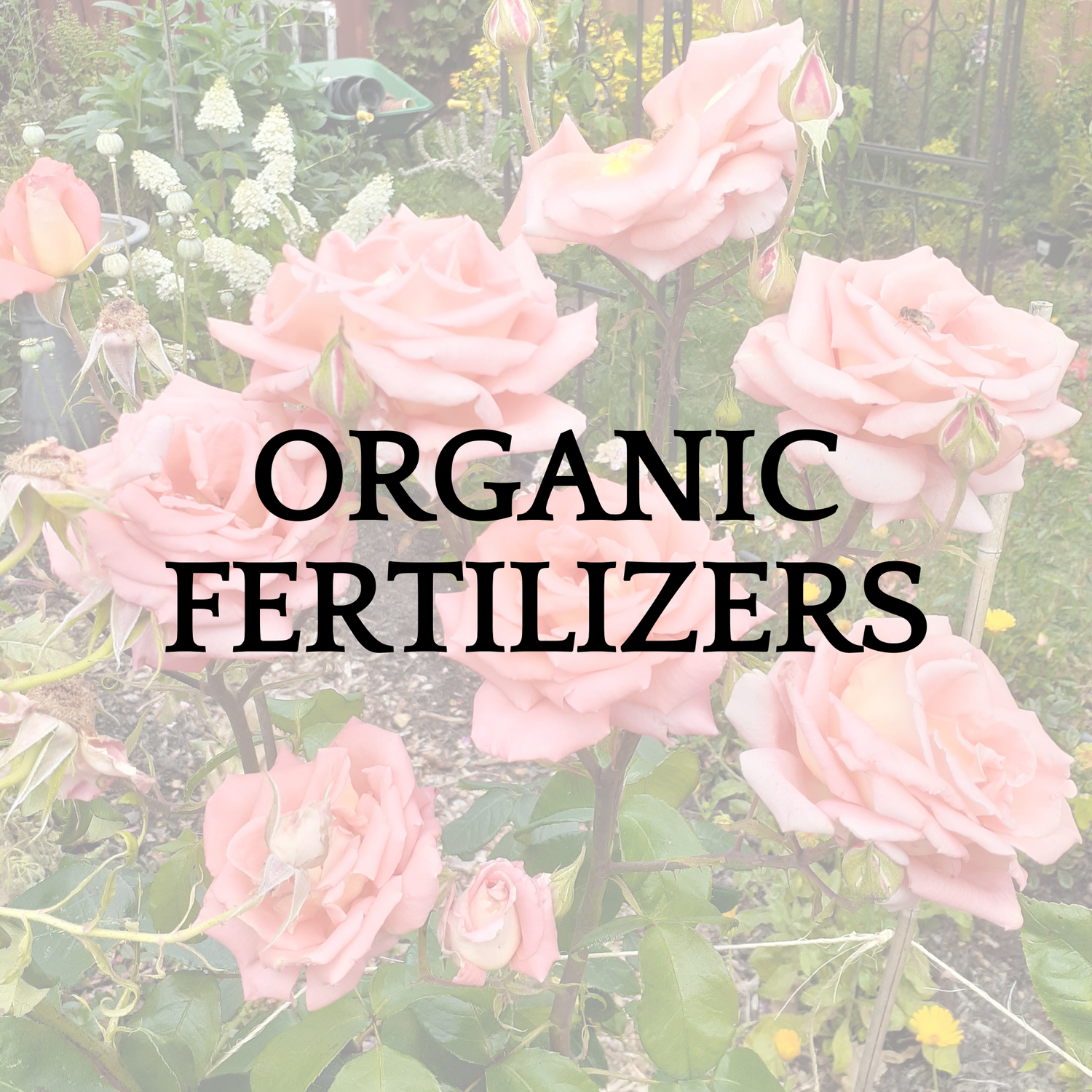Soft Rock Phosphate Fertilizer
Soft Rock Phosphate Fertilizer
Couldn't load pickup availability
NEW on the Pantry shelf!
Unlike my other fertilizers which mostly contain a broad spectrum of nutrients in small amounts, micronized soft rock phosphate is very nutrient specific, delivering 25% phosphate and 23% calcium, plus small amounts of other elements. Micronization means the material has been ground down to a very fine powder. The tiny particles go into suspension when mixed with water and are readily available for plant uptake through roots and foliage.
I chose this particular fertilizer because it addresses two common plant nutritional needs at once.
Phosphorus (P) plays important roles in plant growth from roots to flowers, fruit, and seeds, in energy conversion, and in DNA formation. Like calcium, it supports nitrogen fixing bacteria in the soil. As a negatively charged ion, it does not attach to the soil's fine clay particles, and is not easily stored in soils low in organic matter. It is prone to be washed out of the root zone. Pollution from conventional P over-fertilization is a big problem "downstream"! However, micronized soft rock phosphate is used in very small amounts unlikely to cause harm.
In the long run, it pays off to increase soil organic matter content with compost and mulch. Remember, mycorrhizal fungi also facilitate phosphorus transport to plant roots. In the short run, if you notice acute P deficiency, it makes sense to supply some phosphorus until your organic matter and fungi are in place.
Calcium (Ca) is a hugely important yet often under-appreciated nutrient. Its benefits to plants include strong cell walls and membranes, information transfer between cells, and activation of enzymes. It also supports nitrogen fixing bacteria in the soil. Calcium ions have a positive charge and can be held on clay particles, which is good, but some soils are low in clay. Again, organic matter is our friend, as it improves the soil's ability to hold on to all nutrients, the positively and the negatively charged ones.
There is another aspect of soft rock phosphate that has me excited. The combination of P and Ca supports soil and plant health.
According to organic agriculture pioneer, William Albrecht, calcium in crop producing soils should account for as much as 60% to 68% of soil base saturation for optimum plant health. This is rarely the case outside of limestone based soils. Jay McCaman ("Weeds and Why They Grow"/"When Weeds Talk") and Arden Andersen ("The Anatomy of Life and Energy in Agriculture") took this a step further and showed that occurrence of plant diseases and insect damage, as well as weed presence, are high in soils whose levels of P and Ca are low.
Andersen's work lists common fungal and bacterial problems such as blight, rot (including blossom end rot), leaf spot, wilts and cankers, rust, mold, and mildew; common plant feeding insects like aphids, cutworms, weevils, mites, thrips, flea beetles, fruit worms and borers; and even weeds such as bindweed, dandelion, knotweed or broom; all thriving where there are deficiencies of P and Ca.
It is important to understand that phosphorus and calcium will not act in any way that is toxic to these disease organisms, insects, or unwanted plants. Rather, adequate and balanced levels of key nutrients will empower plants to mobilize their own defenses against their predators. Together with good amounts of soil organic matter and a rich and diverse soil microbiology, soft rock phosphate is one more tool in our organic toolbox.
Made by Reindeer Natural Plant Foods, Lake Cowichan, BC.
Application
Application
How much do you need?
Mix micronized soft rock phosphate with water before application. Seeing how the instructions on the tub are a bit confusing, I recommend the following: Use 10g powder (two teaspoons) in 4 litres of water (one gallon) to cover 1,000 sq ft, three times during the growing season. The liquid can be applied to the soil and is also effective as a foliar spray. Using a watering can or sprayer, water into the soil and/or apply to plant leaves till wet.
How long does it keep?
Soft rock phosphate keeps indefinitely. Store in a dry place with the cap on tight.
Share

FAQ
Shipping & Local Pick-Up
FLAT RATE SHIPPING + LOCAL PICK UP
Flat Rate Shipping across Canada with either Canada Post, Purolator or UPS
| Purchase ($) | Shipping ($) |
| <55 | 15 |
| 55-74 | 20 |
| 75-124 | 25 |
| 125-199 | 30 |
| 200-399 | 40 |
| 400-699 | 55 |
| 700+ | 70 |
LOCAL PICK UP, VICTORIA BC
If you prefer to pick up your order in Victoria, BC, just choose the ‘Pick Up’ option during checkout.
Online order pickups are now at Gardener’s Kit at 169 Langford Street — very close to my old shop in Vic West!
You will receive a pick up confirmation when your order is ready. Click Here for driving directions + Gardener's Kit store hours
Ideally, please allow one business day for order processing. If you need something the same day, or you’d like to meet and chat, give me a quick call or send a text before coming over (250-216-3733) and I will try my best to be ready for you.
What’s the difference between EM and Activated EM? Can I keep re-activating my Activated EM?
I wish! Sadly EM is a bit different from yogurt or sourdough making. The first activation will turn out very closely similar to the mother culture, but with subsequent activations the intricate balance of microbe species and numbers will start to shift, and the effectiveness will decrease. I only ever use fresh mother culture when activating.
EM mother culture can be used the same way as Activated EM, but for economic reasons most people buy it to make their own activation. If you’re new to gardening with EM and you just want to try it out, or if you don’t want to spend the time and effort of activating, then go for the already activated product.
What’s the difference between EM/AEM and Compost Tea?
While EM, AEM, and Compost Tea are made differently, they have similar benefits and compliment each other beautifully. For a comparative summary of these products, see the March 2011 Newsletter.
Can I combine products for easy, all-in-one application?
Yes, almost all products are compatible. The only exception is with fish and sea minerals, which are better applied separately. Keep in mind that dilution rates are different for each product, and try to apply right away after mixing.
Do I need a sprayer?
For soil and compost application, or treating small lawns, a watering can is just fine. For application to foliage, finer droplets are advantageous. You can use a spray bottle, a hose-end sprayer, or a hand-held or backpack sprayer. The wand of a sprayer will help greatly with getting to the underside of leaves. Whatever container you use, be sure it never held any pesticides or liquid synthetic fertilizer.
How do I store the products, and how long do they keep?
Store all products at a cool room temperature, with the lid on tight, and out of direct light. Store pure and undiluted – once products are mixed or diluted with water, they go off quickly. EM mother culture keeps up to two years, activated EM six months or longer. Mycorrhizal fungi, liquid fish, liquid kelp, and sea minerals are good for about a year. Humic acids and molasses can be stored almost indefinitely.
more in The Pantry...
-

Microbial Inoculants
Microbial inoculants aren’t organic fertilizers, but bacteria, fungi, and protists play an...
-

Organic Fertilizers
These organic fertilizers could also be called “biostimulants,” i.e. materials that stimulate...




